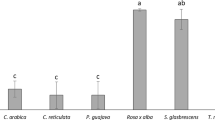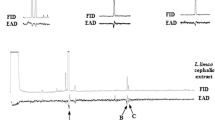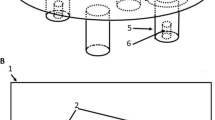Abstract
The response of Atta sexdens rubropilosa Forel workers to essential oils, epicuticular wax and hexane, dichloromethane, ethyl acetate, and methanol extracts of Eucalyptus maculata was evaluated. Hexane extracts of E. maculata interfered with the recognition mechanism among workers. The main active compounds identified from this plant were the sesquiterpenes elemol and β-eudesmol. These compounds may be responsible for the resistance of this species to ant attack.
Similar content being viewed by others
REFERENCES
Adams, R. P. 1995. dentification of Essential Oil Components by Gas Chromatography/Mass Spectroscopy. Allured, New York.
Anjos, N. and Santana, D. L. Q. 1994. Alterações delet´erias no comportamento de Atta laevigata (F. Smith) e Atta sexdens rubropilosa Forel (Hymenoptera: Formicidae), causadas por folhas de Eucalyptus spp. Soc. Entom. Brasil 23:25–30.
Boyd, N. D. and Martin, M. M. 1975. Faecal proteinases of the fungus-growing ant Atta texana: Their fungal origin and ecological significance. Insect Physiol. 21:1815–1820.
Bueno, O. C., Hebling-beraldo, M. J. A., Silva, O. A., Pagnocca, F. C., Fernand es, J. B., and Vieira, P. C. 1990. Toxic effect of plants on leaf-cutting ants and their symbiotic fungus, pp. 420–426, in R. K. Vander Meer, K. Jaffe, and A. Cedeno (eds. ). Applied Myrmecology: A World Perspective. Westview, Boulder, CO.
Carlin, N. F. and H¨olldobler, B. 1987. The kin recognition system of carpenter ants (Camponotus spp. ) II. Larger colonies. Behav. Ecol. Sociobiol. 20:209–217.
Chen, T. K., Wiemer, D. F., and Howard, J. J. 1984. A volatile leafcutter ant repellent from Astronium graveolens. Naturwissenschaften 71:97–98.
Chou, T. S., Lee, S. J., and Yao, N. K. 1989. Total synthesis of racemic selina-3, 7(11)-diene,á-silenene and á-eudesmol. Tetrahedron 45:4113–4124.
Crozier, R. H.s and Dix, M. W. 1979. Analysis of two generic models for the innate components of colony odour in social Hymenoptera. Behav. Ecol. Sociobiol. 4:217–224.
Della lucia, T. M. C. and Fowler, H. G. 1993. As formigas cortadeiras, pp. 1–3, in T. M. C. Della Lucia (ed. ). As Formigas Cortadeiras. Folha de Viçosa, Viçosa, Brazil.
Della lucia, T. M. C., Vilela, E. F., Anjos, N., and Moreira, D. D. O. 1993. Criação de formigas cortadeiras em laborat´orio, pp. 151–162, in T. M. C. DELLA LUCIA (ed. ). As Formigas Cortadeiras. Folha de Viçosa, Viçosa, Brazil.
Dool, H. Van Den and Kratz, P. D. 1963. A generalization of the retention index system including linear temperature programmed gas-liquid partition chromatography. J. Chromatogr. 11:463–471.
Febvay, G., Bourgeois, P., and Kermarrec, A. 1985. Antiappé tants pour la fourmi attini, Acromyrmex octospinosus (Reich) (Hymenoptera, Formicidae), chez certaines especies d'ignames (Dioscoreaceae) cultiv´ees aux Antilles. Agronomie 5:439–444.
Hebling, M. J. A., Bueno, O. C., Pagnocca, F. C., Da silva, O. A., and Maroti, P. S. 2000. Toxic effects of Canavalia ensiformis L. (Leguminosae) on laboratory colonies of Atta sexdens L. (Hym., Formicidae). J. Appl. Ent. 124:33–35.
Hebling, M. J. A., Maroti, P. S., Bueno, O. C., Da silva, O. A., and Pagnocca, F. C. 1996.Toxic effects of leaves of Ricinus communis (Euphorbiaceae) to laboratory nests of Atta sexdens rubropilosa (Hymenoptera: Formicidae). Bull. Ent. Res. 86:253–256.
Hernand ez, J. V., Lopez, H., and Jaff´e, K. 2002. Nestmate recognition signals of the leaf-cuttingant Atta laevigata. J. Insect Physiol. 48:287–295.
Hubbell, S. P. and Wiemer, D. F. 1983. Host plant selection by an attineant, pp. 233–254, in P. Jaisson (ed. ). Social Insects in the Tropics, Vol. 2. University of Paris Press, Paris.
Jolad, S. D., Timmermann, B. N., Hoffmann, J. J., Bates, R. B., Camou, F. A., and Siahaan, T. J. 1988. Sesquiterpenes glycosides and an acetogenin glucoside from Lessingia gland ulifera. Phytochemistry 27:2199–2204.
Jutsum, A. R., Saunders, R. S., and Cherrett, J. M. 1979. Intraspecific aggression in the leaf-cuttingant Acromyrmex octospinosus. Anim. Behav. 27:839–844.
Lahav, S., Soroker, V., and Hefetz, A. 1999. Direct behavioral evidence for hydrocarbons as ant recognition discriminators. Naturwissenchaften 86:246–249.
Lenoir, A., Fresneau, D., Errard, C., and Hefetz, A. 1999. Individuality and colonial identity in ants: The emergence of social representation concept, pp. 219–237, in C. Detrain, J. L. Deneuborg, and J. M. Pasteels (eds.). Information Processing in Social Insects, 432 pp. Birkhauser Verlag, Basel, Switzerland.
Martin, M. M., Boyd, N. D., Gieselmann, M. J., and Silver, R. G. 1975. Activity of faecal fluid of a leaf-cutting ant toward plant cell wall polysaccharides. J. Insect Physiol. 21:1887–1892.
Martin, M. M., Carman, R. M., and Macconnel, J. G. 1969. Nutrients derived from the fungus cultured by the fungus-growing ant Atta colombica tonsipes. Ann. Ent. Soc. Am. 62:11–13.
Santana, D. L. Q., Della lucia, T. M. C., and Zanuncio, J. C. 1990. Influência do formato de amostras de folhas de Eucalyptus spp. na atratividade a formigas cortadeiras Atta spp. (Hymenoptera: Formicidae). An. Soc. Entom. Brasil 19:72–80.
Silva, A., Bacci, M., JR., Siqueira, C. G., Bueno, O. C., Pagnocca, F. C., and Hebling, M. J. A. 2003. Survival of Atta sexdens workers on different food sources. J. Insect Physiol. 49:307–311.
Siqueira, J. D. P. 1990. A atividade florestal como um dos instrumentos de desenvolvimento do Brasil, pp. 15–18, in Congresso Florestal Brasileiro, VI. Campos do Jordão, SP. Anais.
Su, W.-C., Fang, J.-M., and Cheng, Y.-S. 1995. Sesquiterpenes from leaves of Cryptomeria japonica. Phytochemistry 39:603–607.
Viana, A. M. M., FrÉzard, A., Malosse, C., Della lucia, T. M. C., Errard, C., and Lenoi R, A. 2001. Colonial recognition of fungus in the fungus-growing ant Acromyrmex subterraneus subterraneus (Hymenoptera: Formicidae). Chemoecology 11:29–36.
Weber, N. A. 1972. Gardeningants, the Attines. Am. Philos. Soc. XX:146.
Wiemer, D. F. 1985. Natural repellents of the leaf cutting ants. Rev. Latinoam. Quim. 16:98–102.
Wilson, E. O. 1980. Caste and division of labor in leaf-cutter ants (Hymenoptera: Formicidae: Atta). Behav. Ecol. Sociobiol. 7:l43–l56.
Author information
Authors and Affiliations
Rights and permissions
About this article
Cite this article
Marsaro, A.L., Souza, R.C., Della Lucia, T.M.C. et al. Behavioral Changes in Workers of the Leaf-Cutting Ant Atta sexdens rubropilosa Induced by Chemical Components of Eucalyptus maculata Leaves. J Chem Ecol 30, 1771–1780 (2004). https://doi.org/10.1023/B:JOEC.0000042400.14451.08
Issue Date:
DOI: https://doi.org/10.1023/B:JOEC.0000042400.14451.08




